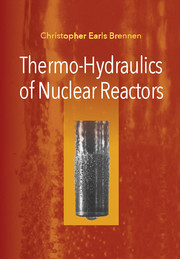6 - Multiphase Flow
Published online by Cambridge University Press: 05 April 2016
Summary
Introduction
A multiphase flow is the flow of a mixture of phases or components. Such flows occur in the context of nuclear power generation either because the reactor (such as a BWR) is designed to function with a cooling system in which the primary coolant consists of several phases or components during normal operation or because such flows might occur during a reactor accident. In the latter context, predictions of how the accident might progress or how it might be ameliorated may involve analyses of complicated and rapidly changing multiphase flows. Consequently, some familiarity with the dynamics of multiphase flows is essential to the nuclear reactor designer and operator. This chapter provides a summary of the fundamentals of the dynamics of multiphase flows. In general, this is a subject of vast scope that ranges far beyond the limits of this book. Consequently, the reader will often be referred to other texts for more detailed analyses and methodologies.
Multiphase Flow Regimes
From a practical engineering point of view, one of the major design difficulties in dealing with multiphase flow is that the mass, momentum, and energy transfer rates and processes can be quite sensitive to the geometric distribution or topology of the components within the flow. For example, the topology may strongly affect the interfacial area available for mass, momentum, or energy exchange between the phases. Moreover, the flow within each phase or component will clearly depend on that geometric distribution. Consequently, there is a complicated two-way coupling between the flow in each of the phases or components and the geometry of the flow (as well as the rates of change of that geometry). The complexity of this two-way coupling presents a major challenge in the analysis and prediction of multiphase flows.
Information
- Type
- Chapter
- Information
- Thermo-Hydraulics of Nuclear Reactors , pp. 90 - 126Publisher: Cambridge University PressPrint publication year: 2016
